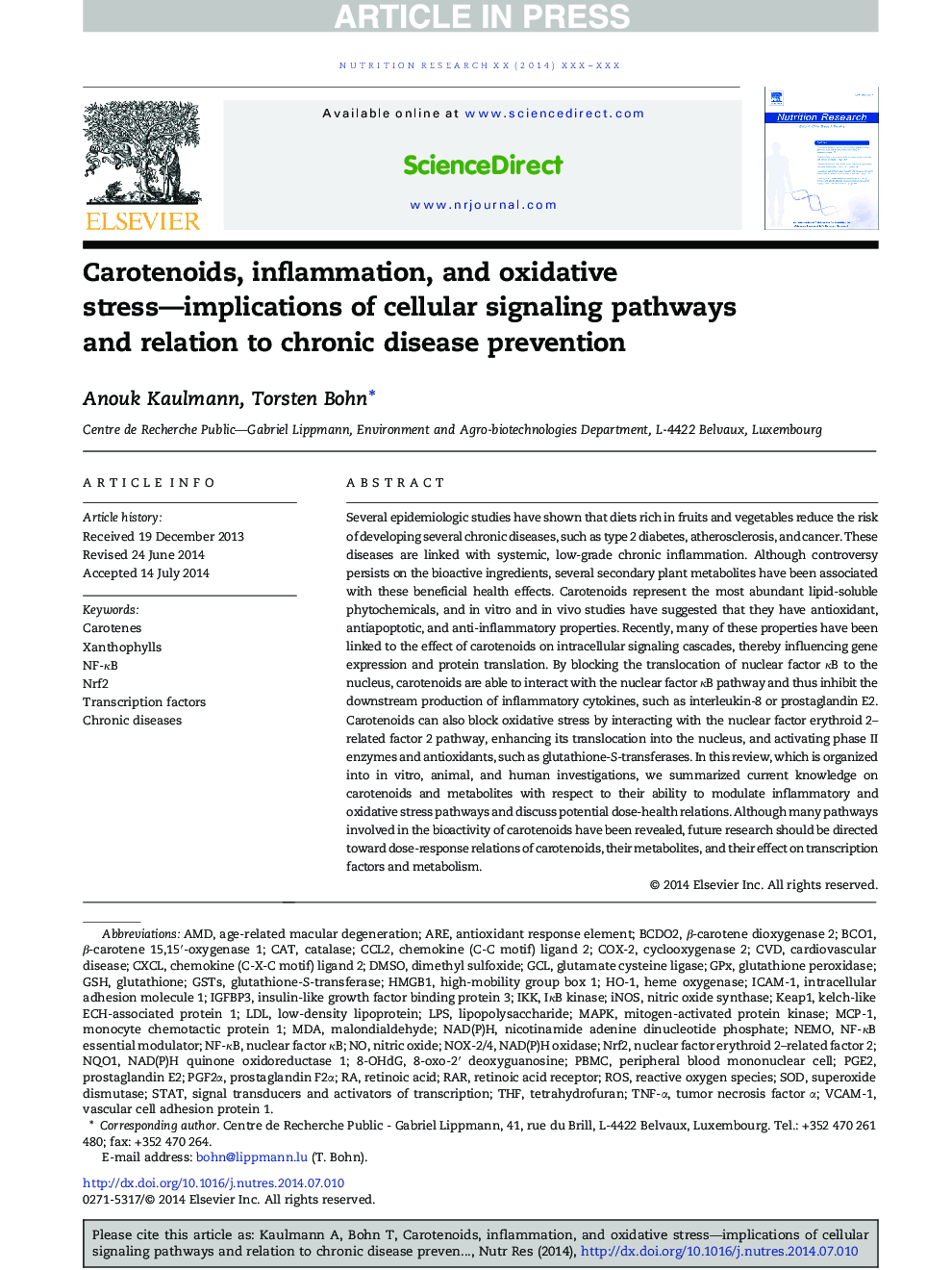| کد مقاله | کد نشریه | سال انتشار | مقاله انگلیسی | نسخه تمام متن |
|---|---|---|---|---|
| 5904584 | 1158014 | 2014 | 23 صفحه PDF | دانلود رایگان |
عنوان انگلیسی مقاله ISI
Carotenoids, inflammation, and oxidative stress-implications of cellular signaling pathways and relation to chronic disease prevention
ترجمه فارسی عنوان
کاروتنوئیدها، التهاب و استرس اکسیداتیو پیامدهای مسیرهای سیگنالینگ سلولی و ارتباط آن با پیشگیری از بیماری مزمن
دانلود مقاله + سفارش ترجمه
دانلود مقاله ISI انگلیسی
رایگان برای ایرانیان
کلمات کلیدی
NEMOGSHGPXXanthophyllsHO-1COX-2AMDiNOSPGE2PGF2αMCP-18-OHdGICAM-1IGFBP3RARGCLIKKHMGB1GSTschemokine (C-X-C motif) ligand 2CXCLVCAM-1NQO1NF-κBNrf2PBMCCCL2MDACATTHFBCO1LPSkeap1 - buy1DMSO - DMSOIκB kinase - IkB kinaseMAPK - MAPKNAD(P)H - NAD (P) HNAD(P)H oxidase - NAD (P) H اکسیدازNAD(P)H Quinone Oxidoreductase 1 - NAD (P) H کوئینون اکسیدوردوکتاز 1ROS - ROSSTAT - آمارcardiovascular disease - بیماری قلب و عروقیChronic diseases - بیماری های مزمنTetrahydrofuran - تتراهیدروفورانtumor necrosis factor α - تومور نکروز عامل αhigh-mobility group box 1 - جعبه گروه تحریر بالا 1Dimethyl sulfoxide - دیمتیل سولفواکسیدRetinoic acid - رتینوئیک اسیدCVD - رسوب دهی شیمیایی بخار SOD - سدPeripheral blood mononuclear cell - سلول تک هسته ای خون محیطیage-related macular degeneration - سن تخریب ماکولا مربوط به سن استSuperoxide dismutase - سوکسوکس دیسموتازcyclooxygenase 2 - سیکلوکوکسیژناز 2Nuclear factor erythroid 2–related factor 2 - عامل فاکتور هسته ای عامل ارثیری 2 مرتبط 2antioxidant response element - عنصر پاسخ آنتی اکسیدانTranscription factors - عوامل رونویسیTNF-α - فاکتور نکروز توموری آلفاnuclear factor κB - فاکتور هسته ای κBLow-density lipoprotein - لیپوپروتئین کم چگالی یا الدیال LDL - لیپوپروتئین کم چگالی(کلسترول بد)lipopolysaccharide - لیپوپلی ساکاریدglutamate cysteine ligase - لیگاز سیتئین گلوتاماتmalondialdehyde - مالون دی آلدهیدsignal transducers and activators of transcription - مبدل سیگنال و فعال کننده رونویسیNF-κB essential modulator - مدولاتور ضروری NF-κBintracellular adhesion molecule 1 - مولکول چسبندگی داخل سلولی 1Nitric oxide - نیتریک اکسیدnitric oxide synthase - نیتریک اکسید سنتازnicotinamide adenine dinucleotide phosphate - نیکوتین آمید adenine dinucleotide phosphateARE - هستندheme oxygenase - همگام اکسژنازmonocyte chemotactic protein 1 - پروتئین chemotactic monocyte 1Insulin-like growth factor binding protein 3 - پروتئین اتصال دهنده فاکتور رشد مانند انسولین 3Kelch-like ECH-associated protein 1 - پروتئین مرتبط با ECH کلچ 1vascular cell adhesion protein 1 - پروتئین چسبندگی سلولی عروقی 1mitogen-activated protein kinase - پروتئین کیناز فعال با mitogenProstaglandin E2 - پروستاگلاندین E2Prostaglandin F2α - پروستاگلاندین F2αCatalase - کاتالازCarotenes - کاروتن هاchemokine (C-C motif) ligand 2 - کیموکین (C-C motif) لیگاند 2Glutathione - گلوتاتیونglutathione-S-transferase - گلوتاتیون S-ترانسفرازglutathione peroxidase - گلوتاتیون پراکسیدازReactive oxygen species - گونههای فعال اکسیژنRetinoic acid receptor - گیرنده اسید رتینوئیک
موضوعات مرتبط
علوم زیستی و بیوفناوری
بیوشیمی، ژنتیک و زیست شناسی مولکولی
علوم غدد
چکیده انگلیسی
Several epidemiologic studies have shown that diets rich in fruits and vegetables reduce the risk of developing several chronic diseases, such as type 2 diabetes, atherosclerosis, and cancer. These diseases are linked with systemic, low-grade chronic inflammation. Although controversy persists on the bioactive ingredients, several secondary plant metabolites have been associated with these beneficial health effects. Carotenoids represent the most abundant lipid-soluble phytochemicals, and in vitro and in vivo studies have suggested that they have antioxidant, antiapoptotic, and anti-inflammatory properties. Recently, many of these properties have been linked to the effect of carotenoids on intracellular signaling cascades, thereby influencing gene expression and protein translation. By blocking the translocation of nuclear factor κB to the nucleus, carotenoids are able to interact with the nuclear factor κB pathway and thus inhibit the downstream production of inflammatory cytokines, such as interleukin-8 or prostaglandin E2. Carotenoids can also block oxidative stress by interacting with the nuclear factor erythroid 2-related factor 2 pathway, enhancing its translocation into the nucleus, and activating phase II enzymes and antioxidants, such as glutathione-S-transferases. In this review, which is organized into in vitro, animal, and human investigations, we summarized current knowledge on carotenoids and metabolites with respect to their ability to modulate inflammatory and oxidative stress pathways and discuss potential dose-health relations. Although many pathways involved in the bioactivity of carotenoids have been revealed, future research should be directed toward dose-response relations of carotenoids, their metabolites, and their effect on transcription factors and metabolism.
ناشر
Database: Elsevier - ScienceDirect (ساینس دایرکت)
Journal: Nutrition Research - Volume 34, Issue 11, November 2014, Pages 907-929
Journal: Nutrition Research - Volume 34, Issue 11, November 2014, Pages 907-929
نویسندگان
Anouk Kaulmann, Torsten Bohn,
